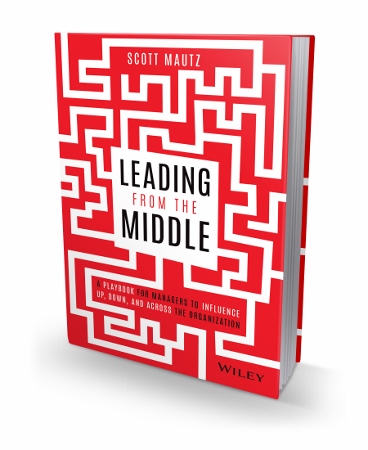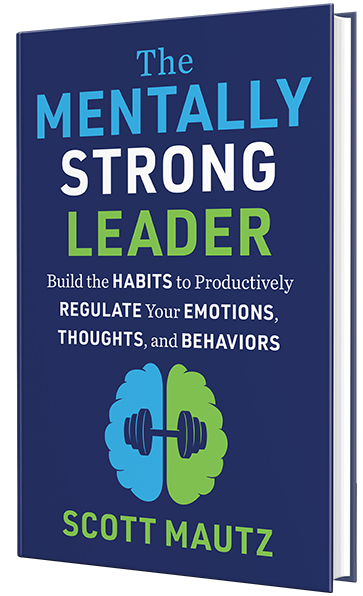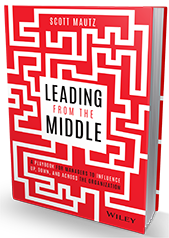
You’re probably surprised to see servant leadership in my crosshairs. After all, it’s a beloved form of leadership for those with a soul.
Classic servant leadership is built on an inverted leadership hierarchy where the leader’s main function is to serve those below him or her, putting employees needs first, rather than vice versa.
I’m a fan of it because it’s not all about you. It’s about helping everyone and everything around you to thrive. It’s about the ecosystem, not the ego system.
But servant leadership does have issues, as I confirmed repeatedly in interviewing over 3,000 successful mid-level executives for my new book, Leading from the Middle: A Playbook for Managers to Influence Up, Down, and Across the Organization.
I’ll share 4 problems with the classic servant leader approach and then share an alternative.
1. Servant leaders can be pegged as too “soft.”
I’ve seen proud servant leaders value how they achieve results far more than actually achieving those results. As a result, they underdelivered business results because they were focused on meeting the needs of their people to a fault.
I’ve seen well-meaning servant leaders fail to spend as much time and energy on planning and executing to achieve company goals as helping individuals achieve theirs.
2. Servant leaders can fail to establish their authority and mastery.
Research shows that servant leaders can over-abdicate authority and fade into the woodwork in their attempt to “lead from behind,” inadvertently becoming invisible to the organization as to their impact. They might take refuge in the comfort of serving their employees, not wanting to engage up the chain as much (which can be the opposite of comforting) and thus not establishing as strong a presence with their leaders.
All organizations love servant leaders, but they also want to know those leaders are highly competent leaders in their own right, with authority, control, and the ability to influence in all directions.
3. Servant leaders can struggle with authoritative, command and control–type leaders.
Classic servant leaders often run into conflict with bosses who don’t share the same leadership philosophies. For example, priorities can quickly clash with the servant leader seeking to protect the people first, and their leader wanting to protect profit first.
And related to number two above, the boss might want to see their subordinates with a servant leader style more clearly distinguish themselves from followers, believing that the servant leader style sacrifices the establishment of authority and mastery. This can chip away at the servant leader’s credibility in the eyes of their boss, making it more difficult for that servant leader to get the resources and support needed to best serve their constituents. I’ve personally experienced this.
4. Servant leaders can be too one-dimensional in where their energy goes.
In their zeal to serve subordinates, they can underserve their chain of command, peers, and even underserve themselves. Reports of compassion fatigue (getting burned out in trying to always put others needs first) are not uncommon with servant leaders.
So, what’s the alternative, then, to servant leadership?
Others-Oriented Leadership
Let’s not throw the baby out with the bathwater here, as the saying goes. Think of Others-Oriented Leadership as being a leader with a servant’s heart at the core, but one who adjusts for the pitfalls of classic servant leadership as outlined above. Here’s what the job description of an Others-Oriented Leader would look like:
“You start with a servant’s heart. You don’t think less of yourself; you just think of yourself less. You know that strength doesn’t make you capable of rule, it makes you capable of service.
But service doesn’t mean subservience.
While power flows through you in servitude, you don’t deny your power, knowing when it must flow from you. You lead with others in mind, but make no mistake, you serve and you lead—you don’t lose your authoritative leadership qualities along the way.
You know when it’s time to command and direct, stepping up to lead from the front, versus stepping back and staying in the shadows to support. And you recognize when your chain of command wants to see this shift.
You direct energy and focus in every direction, up, down, and across the organization, not just downward—and yes, while not forgetting to serve yourself as well.
You recognize at times you must first serve what the business needs, not what the people want. You know that what’s needed for the business and/or employees doesn’t always feel good.
But despite the tension, you proceed with deliberateness, and always with empathy.
You think like an engineer, feel like an artist.”
So, practice Others-Oriented Leadership and your business and people results will stand out from others.
EXCITING NEWS – You can now pre-order my new book, already an Amazon #1 BEST-SELLING new release in Management Science!

Leading from the Middle: A Playbook for Managers to Influence Up, Down, and Across the Organization (publication date is May 18th, 2021). Order here https://amzn.to/3as5tK8 OR… Get a massive BONUS BUNDLE by ordering 5 or more copies here: http://lftm.bulkbooks.com/ Check out a detailed book description here: https://bit.ly/2MLe5Do




Scott, I love this one. Yes, you can LEAD and still have a soul. A leader is someone people follow, difficult to achieve with the purest form of servant leadership. “Think like an engineer, feel like an artist” needs to go on managers’ t-shirt merch.
Thanks so much Maia – and thank you for taking the time to comment! Indeed, you can still lead and have a soul!
Cheers,
Scott
Excellent observations and distinction. I am a servant leader who has experienced all of the potential pitfalls you mentioned. Others-Oriented Leadership from this point forward!
Thanks so much Tim, and for taking the time to comment. I too am a servant leader that has learned some of the lessons I share the hard way!
Cheers,
Scott
Scott, I agree with the concept of leading from the middle. It seems to give a feel for what is going on within the organization without giving up the steering for the direction of the organization.
If a CEO thinks and acts like an experienced servant-leader/servant-follower; the organization’s overall needs must come first! The CEO must seek to employ and reward individuals who have the skill sets required to meet the organization’s specific missions, and measurable goals/objectives. These key individuals will “Lead from the Middle” of each project team.
Key leadership skills that encourage and reward empathy and respectful lines of caring communication are necessary!
Goods thoughts Edward – thanks for sharing!
This so resonates with my work history and I’ve fallen fall all the pitfalls plus noticed when org structures change or therebis new senior management then you can be pigeon-holed and demoted because it’s seen you are working for and reporting to those you actually weren leqding
Right on Cameron! Thanks for your comment.
Cheers,
Scott
Great point!